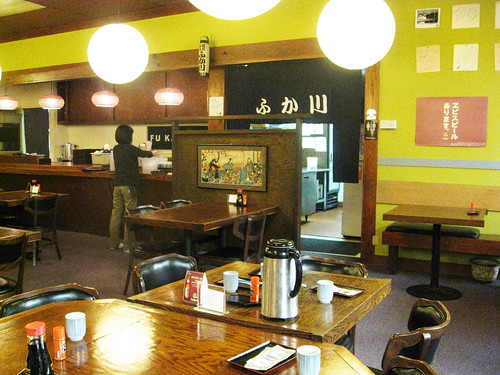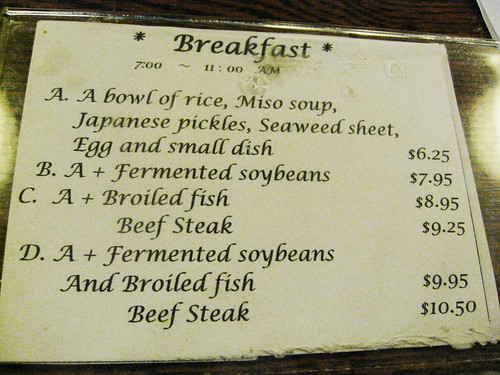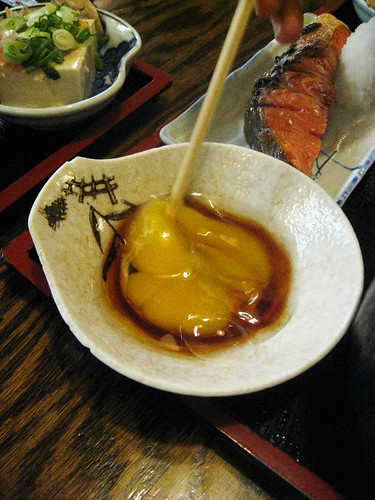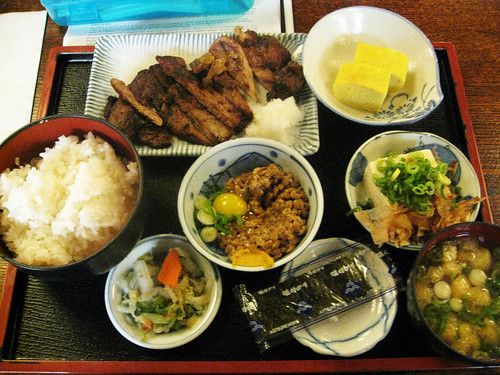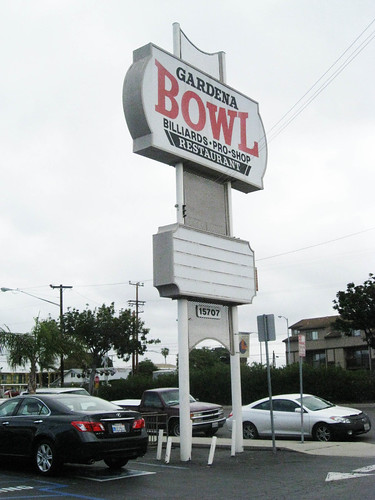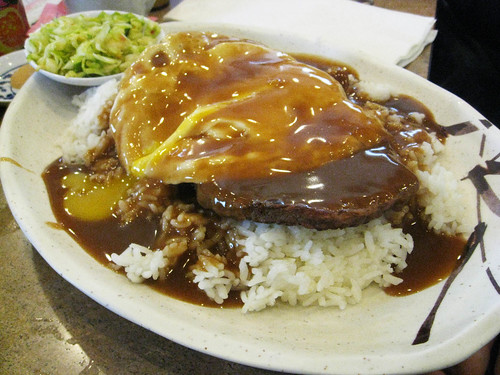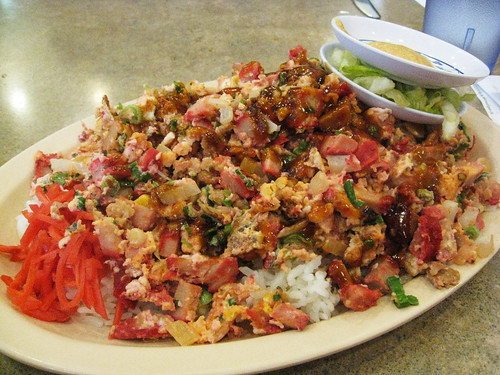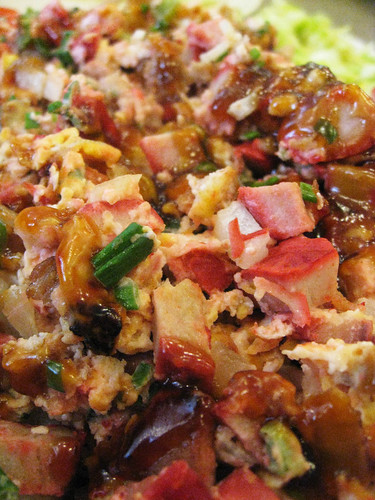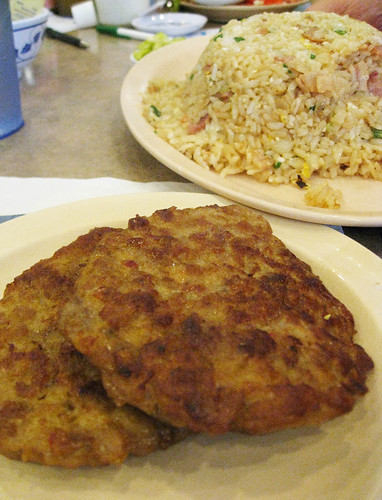 Latter part of last year, I organized my quarterly "Quartet" dining series for my group and this time around, we focused on checking out 4 Ramen restaurants from October to December. The four places we visited were Koraku, Hakata Ramen, Santouka Ramen and Daikokuya.
Latter part of last year, I organized my quarterly "Quartet" dining series for my group and this time around, we focused on checking out 4 Ramen restaurants from October to December. The four places we visited were Koraku, Hakata Ramen, Santouka Ramen and Daikokuya.
First up was Koraku in Little Tokyo. While strictly not a ramen house, what was interesting about Koraku was the sheer number and variety of ramen soups being offered. There was quite a list in the menu as well as special ramens being offered just for that day. For my order, I chose one of the specials called Sutamina Ramen, which had a shoyu (I think) broth and included garlic sprouts, ground pork, green onions and mushrooms.
If you were looking for something warm to ward off a cold day or night, I'd say this particular ramen would accomplish that just fine. It was a good solid dish, if not spectacular. There were certainly misses to it. I would have preferred firmer noodles. The broth was also a little too thin and there was a layer of oiliness towards the top of the broth that could have been lessened.
Also, I don't think ground meat really is a good choice for ramen or even soup in general. The ground pork in my ramen basically weighted itself to the bottom of the bowl. I almost forgot that it was there until I was half way done with my soup and finally started picking the meat up with my spoon. Even with all those cons, this ramen still had some good flavor coming from the garlic sprouts and green onions and that at least was satisfying. Would I come to Koraku again? Yes, if only to try out some of the other options on the menu. I just wouldn't order the Sutamina Ramen again.
 From Koraku, we traversed all the way to Gardena to check out Hakata Ramen and it was certainly night and day. I'm a definite carnivore because I just loved the meatiness, porkiness of the Tonkotsu broth that came with my ramen. What I also really liked was being able to customize my ramen eating experience. Firm noodles? Check. Normal soup oil? Yes. Strong soup base? Definitely. At Koraku, I ate my ramen. At Hakata, I experienced my ramen. It was just that good. The broth was rich and hearty. I really felt like I was having meal vs. just soup. I also loved the spice factor of the spicy miso ball that I added to the broth and honestly, probably could have added another one for even more action.
From Koraku, we traversed all the way to Gardena to check out Hakata Ramen and it was certainly night and day. I'm a definite carnivore because I just loved the meatiness, porkiness of the Tonkotsu broth that came with my ramen. What I also really liked was being able to customize my ramen eating experience. Firm noodles? Check. Normal soup oil? Yes. Strong soup base? Definitely. At Koraku, I ate my ramen. At Hakata, I experienced my ramen. It was just that good. The broth was rich and hearty. I really felt like I was having meal vs. just soup. I also loved the spice factor of the spicy miso ball that I added to the broth and honestly, probably could have added another one for even more action.
Along with the soup, our group also sampled each other's various side dishes, which included the rice ball (more triangle actually), spam musubi, the mini gyoza and the grounded chicken bowl. I didn't really find anything that special about the gyoza or the chicken bowl. I found the rice ball moist and I liked how they weren't skimpy with mushrooms and carrots that were mixed with the rice. Being Filipino, I was raised on spam, so I definitely felt at home with the spam musubi. I definitely had a great meal there and am looking forward to a return visit.
 The South Bay was certainly putting a lot of miles on my car because our next ramen outing was at Santouka in Torrance. I have to say that of all the ramens I tried in this dining series, the shio ramen that I had at Santouka surprised me the most. When researching the differences between all the different kinds of ramen broths, shio was described as being a clear, almost transparent chicken broth. The shio broth at Santouka was rich, milky looking and reminded me more of Tonkotsu (pork-bone) broth. Of course, when I got home and read through Chowhound postings again, there was a reference from "rameniac" stating that Santouka's shio broth was actually a shio-tonkotsu hybrid, so the Ah-ha came into play at that point.
The South Bay was certainly putting a lot of miles on my car because our next ramen outing was at Santouka in Torrance. I have to say that of all the ramens I tried in this dining series, the shio ramen that I had at Santouka surprised me the most. When researching the differences between all the different kinds of ramen broths, shio was described as being a clear, almost transparent chicken broth. The shio broth at Santouka was rich, milky looking and reminded me more of Tonkotsu (pork-bone) broth. Of course, when I got home and read through Chowhound postings again, there was a reference from "rameniac" stating that Santouka's shio broth was actually a shio-tonkotsu hybrid, so the Ah-ha came into play at that point.
But not having that reference handy, I worked through my surprise and proceeded to enjoy my shio ramen. While the noodles could have been firmer, the broth was fantastic. What I found interesting is that the hybrid version definitely had a cleaner and smoother taste to it, similar to a more traditional shio broth, but I also appreciated the tonkotsu's contribution of a richer, stockier soup. It was practically the best of both worlds. Along with the soup, I enjoyed both the leek rice and the egg that came with my set. The leeks added a nice hit of "green" flavor to the rice while I actually enjoyed the egg on its own without even adding it to my soup.
shio ramen. While the noodles could have been firmer, the broth was fantastic. What I found interesting is that the hybrid version definitely had a cleaner and smoother taste to it, similar to a more traditional shio broth, but I also appreciated the tonkotsu's contribution of a richer, stockier soup. It was practically the best of both worlds. Along with the soup, I enjoyed both the leek rice and the egg that came with my set. The leeks added a nice hit of "green" flavor to the rice while I actually enjoyed the egg on its own without even adding it to my soup.
 Finally, the "Quartet" ends at Daikokuya back in Little Tokyo. Daikokuya's claim to fame is that they only have one kind of broth for their ramen and that's the Tonkotsu broth. With having visited Hakata Ramen earlier in this dining series, I couldn't help but compare their version of Tonkotsu broth to that of Daikokuya. Both broths were rich in porky flavor, hearty and definitely mind-boggingly delicious, but there was a subtle difference between the two.
Finally, the "Quartet" ends at Daikokuya back in Little Tokyo. Daikokuya's claim to fame is that they only have one kind of broth for their ramen and that's the Tonkotsu broth. With having visited Hakata Ramen earlier in this dining series, I couldn't help but compare their version of Tonkotsu broth to that of Daikokuya. Both broths were rich in porky flavor, hearty and definitely mind-boggingly delicious, but there was a subtle difference between the two.
To my palate, the Hakata ramen was more refined. It's the part of James Bond that is sophisticated, cool under pressure, elegant. You can taste the porkiness of the broth but it wasn't completely in your face. Daikokuya, on the other hand, was that part of James Bond that was rough and tumble, aggressive and took no prisoners. The broth of Daikokuya's ramen was more intense, more meaty and definitely made its presence known, and just like Hakata Ramen, I did more than eat this soup, I lovingly savored it. Do I prefer one over the other? No. I really enjoy both. As mentioned earlier, I'm just a carnivore kind of girl. When choosing one over the other, it would depend on whether I wanted to dine with James in a tux or with him while he was interrogating someone.
both. As mentioned earlier, I'm just a carnivore kind of girl. When choosing one over the other, it would depend on whether I wanted to dine with James in a tux or with him while he was interrogating someone.
Since I ordered a combo, I also had a salad and pork over rice with my ramen. I really liked the dressing that comes with the salad. It's a creamy citrus dressing that is a good balance between a little sweet and a little tart. The pork over rice was a miss. It was mostly just fat when I would have liked more meat.
Overall, this was a wonderful "Quartet." It was really fun exploring the world of ramen and its many differences, whether it's difference in broth or in how different restaurants cook and/or present them to their customers. Growing up on packaged ramen, it was only last year that I experienced real ramen when I first visited Daikokuya, so I'm definitely stoked that I was able to check out other wonderful options. My definite favorites were Daikokuya and Hakata with Santouka close behind and while I may not necessarily go out of my way to visit Koraku for ramen, at least, I know if I did, I won't be too disappointed.
Koraku Restaurant
314 E 2nd St
Los Angeles, CA 90012
(213) 687-4972
To see pics, go to:
http://www.flickr.com/photos/la_addict/sets/72157594367236845/
Hakata Ramen
2015 W. Redondo Beach Blvd., #C
Gardena, CA, 90247
(310) 329-1335
http://www.shinsengumiusa.com/
To see pics, go to:
http://www.flickr.com/photos/la_addict/sets/72157594395156529/
Santouka Ramen
21515 Western Avenue
Torrance, CA, 90501
(310) 212-1101
To see pics, go to:
http://www.flickr.com/photos/la_addict/sets/72157594468325330/
Daikokuya
327 E 1st St
Los Angeles, CA, 90012
(213) 626-1680
http://www.daikoku-ten.com/dk_home.html
To see pics, go to:
http://www.flickr.com/photos/la_addict/sets/72157594468402395/













